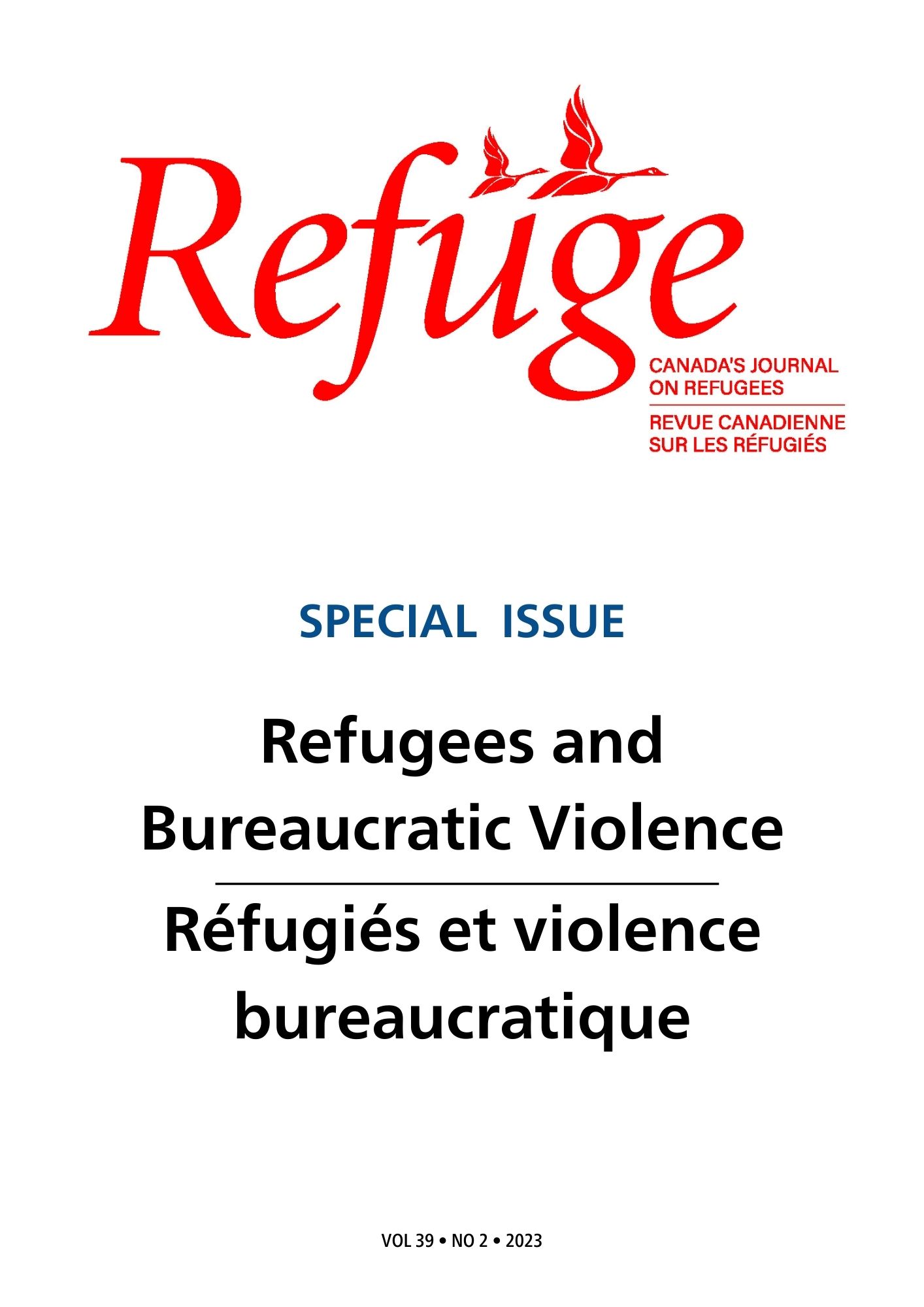Unmasking the Impact of Bureaucratic Violence
DOI:
https://doi.org/10.25071/1920-7336.41163Keywords:
bureaucratic violence, refugees, forced displacement, bureaucraciesAbstract
This introductory article introduces the concept of bureaucratic violence as a partly new way of understanding and analyzing refugees’ encounters with bureaucratic structures within authorities and organizations. Violence or the threat of violence is an inevitable part of the experiences of most forcibly displaced people. In this Special Issue, we highlight how bureaucracies as social institutions, besides providing access to rights, also impact refugees in ways that are constraining, humiliating, soul-killing and, sometimes, life-threatening. We present the theoretical underpinnings of the term bureaucratic violence and, thus, the conceptual framework that connects the different case studies included.
Metrics
References
Abdelhady, D. (2020). Media constructions of the refugee crisis in Sweden: Institutions and the challenges of refugee governance. In D. Abdelhady, N. Gren, & M. Joormann (Eds.), Refugees and the violence of welfare bureaucracies in northern Europe (pp. 122–143). Manchester University Press. https://doi.org/10.7765/9781526146847.00015
Abdelhady, D., & Aly, R. (2022). Coming to and coming from the Middle East: The unfolding of diaspora. In D. Abdelhady & R. Aly (Eds.), Routledge handbook on Middle Eastern diasporas (pp. 1–19). Routledge. https://doi.org/10.4324/9780429266102 DOI: https://doi.org/10.4324/9780429266102-1
Abdelhady, D., Gren, N., & Joormann, M. (Eds.). (2020). Refugees and the violence of welfare bureaucracies in northern Europe. Manchester University Press. https://doi.org/10.7765/9781526146847 DOI: https://doi.org/10.7765/9781526146847
Arendt, H. (1969). Reflections on violence. Journal of International Affairs, 23(1), 1–35. https://www.jstor.org/stable/24356590?seq=1
Arendt, H. (1970). On violence. Harcourt.
Arendt, H. (1976). The origins of totalitarianism. Harcourt. (Work originally published 1951)
Bauman, Z. (1989). Modernity and the Holocaust. Cornell University Press.
Bear, L., & Mathur, N. (2015). Introduction—Remaking the public good: A new anthropology of bureaucracy. The Cambridge Journal of Anthropology, 33(1), 18–34. https://doi.org/10.3167/ca.2015.330103 DOI: https://doi.org/10.3167/ca.2015.330103
Bejan, R., & Glynn, T. (in press). “A total black hole”: Bureaucratic violence and refugees in Greece during COVID. Refuge: Canada's Journal on Refugees.
Bernstein, A., & Mertz, E. (2011). Introduction—Bureaucracy: Ethnography of the state in everyday life. PoLAR: Political and Legal Anthropology Review, 34(1), 6–10. https://doi.org/10.1111/j.1555-2934.2011.01135.x DOI: https://doi.org/10.1111/j.1555-2934.2011.01135.x
Bourdieu, P., & Wacquant, L. (2004). Symbolic violence. In N. Scheper-Hughes & P. Bourgois (Eds.), Violence in war and peace: An anthology (pp. 272–274). Blackwell Publishing.
Davies, T., Isakjee, A., & Dhesi S. (2017). Violent inaction: The necropolitical experience of refugees in Europe. Antipode, 49(5), 1263–1284. https://doi.org/10.1111/anti.12325 DOI: https://doi.org/10.1111/anti.12325
du Gay, P. (2000). In praise of bureaucracy: Weber, organization, ethics. Sage. DOI: https://doi.org/10.4135/9781446217580
du Gay, P. (Ed.). (2005). The value of bureaucracy. Oxford University Press. https://doi.org/10.1093/oso/9780199275458.001.0001 DOI: https://doi.org/10.1093/oso/9780199275458.001.0001
Duran, E. (2006). Healing the soul wound: Counseling with American Indians and other Native people. Teachers College Press.
Dwyer, P., & Nettelbeck, A. (Eds.). (2018). Violence, colonialism and empire in the modern world. Palgrave Macmillan. https://doi.org/10.1007/978-3-319-62923-0 DOI: https://doi.org/10.1007/978-3-319-62923-0
Eggebø, H. (2010). The problem of dependency: Immigration, gender, and the welfare state. Social Politics, 17(3), 295–322. https://doi.org/10.1093/sp/jxq013 DOI: https://doi.org/10.1093/sp/jxq013
Eldridge, E. R. (2018). Administrating violence through coal ash policies and practices. Conflict and Society, 4(1), 99–115. https://doi.org/10.3167/arcs.2018.040109 DOI: https://doi.org/10.3167/arcs.2018.040109
Eldridge, E. R., & Reinke, A. J. (2018). Introduction: Ethnographic engagement with bureaucratic violence. Conflict and Society, 4, 94–99. https://doi.org/10.3167/arcs.2018.040108 DOI: https://doi.org/10.3167/arcs.2018.040108
Elsrud, T. (2023). Fragmentation of hope through tiny acts of bureaucratic cruelty: Another kind of war on Afghan people seeking asylum in Sweden. Refuge: Canada’s Journal on Refugees, 39(2), 1–17. https://doi.org/10.25071/1920-7336.41064 DOI: https://doi.org/10.25071/1920-7336.41064
Espiritu, Y. L., Duong, L., Vang, M., Bascara, V., Um, K., Sharif, L., & Hatton, N. (2022). Departures: An introduction to critical refugee studies. University of California Press. https://doi.org/10.2307/j.ctv2vr8vfw DOI: https://doi.org/10.2307/j.ctv2vr8vfw
Evans, I. (1997). Bureaucracy and race: Native administration in South Africa. University of California Press. http://ark.cdlib.org/ark:/13030/ft2n39n7f2/ DOI: https://doi.org/10.1525/9780520918245
Fanon, F. (2008). Black skin, white masks. Grove Press.
Fanon, F. (2014). The wretched of the earth. Penguin Classics. (Original work published 1970)
Farmer, P. (2004). An anthropology of structural violence. Current Anthropology, 45(3), 305–325. https://doi.org/10.1086/382250 DOI: https://doi.org/10.1086/382250
Fassin, D. (2013). Enforcing order: An ethnography of urban policing. Polity.
Fassin, D. (2015). Introduction: Governing precarity. In D. Fassin et al., At the heart of the state: Themoral world of institutions (pp. 1–14). Pluto Press. https://doi.org/10.2307/j.ctt183p5tb.6 DOI: https://doi.org/10.2307/j.ctt183p5tb.6
Foucault, M. (2003). Society must be defended: Lectures at the Collège de France, 1975–1976 (M. Bertani & A. Fontana, Eds.). Picador.
Fox, C. (2012). Three worlds of relief: Race, immigration, and the American welfare state from the progressive era to the New Deal. Princeton University Press. https://www.jstor.org/stable/j.ctt7sq50 DOI: https://doi.org/10.23943/princeton/9780691152233.001.0001
Galtung, J. (1990). Cultural violence. Journal of Peace Research, 27(3), 291–305. https://www.jstor.org/stable/423472 DOI: https://doi.org/10.1177/0022343390027003005
Giansanti, E., Lindberg, A., & Joormann, M. (2022). The status of homelessness: Access to housing for asylum-seeking migrants as an instrument of migration control in Italy and Sweden. Critical Social Policy, 42(4), 586–606. https://doi.org/10.1177/02610183221078437 DOI: https://doi.org/10.1177/02610183221078437
Graeber, D. (2015). The utopia of rules: On technology, stupidity, and the secret joys of bureaucracy. Melville House.
Graham, M. (2003). Emotional bureaucracies: Emotions, civil servants, and immigrants in the Swedish welfare state. Ethos, 30(3), 199–226. https://www.jstor.org/stable/3651871 DOI: https://doi.org/10.1525/eth.2002.30.3.199
Gren, N. (2020). Living bureaucratisation: Young Palestinian men encountering a Swedish introductory programme for refugees. In D. Abdelhady, N. Gren, & M. Joormann (Eds.), Refugees and the violence of welfare bureaucracies in northern Europe (pp. 161–179). Manchester University Press. https://doi.org/10.7765/9781526146847.00018 DOI: https://doi.org/10.7765/9781526146847.00018
Gupta, A. (2012). Red tape: Bureaucracy, structural violence, and poverty in India. Duke University Press. https://doi.org/10.2307/j.ctv125jn9d DOI: https://doi.org/10.1215/9780822394709
Herzfeld, M. (1992). The social production of indifference: Exploring the symbolic roots of Western bureaucracy. Routledge. https://doi.org/10.4324/9781003135029 DOI: https://doi.org/10.4324/9781003135029
Holmes, S. M., & Castañeda, H. (2016). Representing the “European refugee crisis” in Germany and beyond: Deservingness and difference, life and death. American Ethnologist, 43(1), 12–24. https://doi.org/10.1111/amet.12259 DOI: https://doi.org/10.1111/amet.12259
Huber, C., & Munro, I. (2014). “Moral distance” in organizations: An inquiry into ethical violence in the works of Kafka. Journal of Business Ethics, 124(2), 259–269. https://www.jstor.org/stable/24033267 DOI: https://doi.org/10.1007/s10551-013-1865-1
Jansen, S., & Löfving, S. (Eds). (2009). Struggles for home: Violence, hope and the movement of people. Berghahn Books. https://www.jstor.org/stable/j.ctt9qd582
Joormann, M. (2015). From Malmö to Lesbos: Tracing a trans-European network of voluntary work and activism for refugees. Newsletter of the European Group for the Study of Deviance and Social Control, 10, 12–18. http://www.europeangroup.org/?q=node/97
Joormann, M. (2020). Social class, economic capital and the Swedish, German and Danish asylum systems. In D. Abdelhady, N. Gren, & M. Joormann (Eds.), Refugees and the violence of welfare bureaucracies in northern Europe (pp. 31–49). Manchester University Press. https://doi.org/10.7765/9781526146847.00009 DOI: https://doi.org/10.7765/9781526146847.00009
Kelly, T. (2012) Sympathy and suspicion: Torture, asylum, and humanity. Journal of the Royal Anthropological Institute, 18(4), 753–768. https://doi.org/10.1111/j.1467-9655.2012.01790.x DOI: https://doi.org/10.1111/j.1467-9655.2012.01790.x
Lewis, R., & Mills, S. (Eds.). (2003). Feminist postcolonial theory: A reader. Routledge. https://doi.org/10.4324/9780203825235 DOI: https://doi.org/10.1515/9781474470254
Lindberg, A. (2020). Minimum rights policies targeting people seeking protection in Denmark and Sweden. In D. Abdelhady, N. Gren, & M. Joormann (Eds.), Refugees and the violence of welfare bureaucracies in northern Europe (pp. 85–104). Manchester University Press. https://doi.org/10.7765/9781526146847.00012 DOI: https://doi.org/10.7765/9781526146847.00012
Lins França, I., & Ribeiro, B. (in print). Multiple encounters: Queer asylum seekers and bureaucratic violence. Refuge: Canada’s Journal on Refugees.
Lipsky, M. (1980). Street-level bureaucracy: Dilemmas of the individual in public services. Russell Sage Foundation. https://www.jstor.org/stable/10.7758/9781610447713
Lundberg, A. (2023). “They stopped the lives of others”: Stateless Palestinians facing bureaucratic violence in Sweden. Refuge: Canada’s Journal on Refugees, 39(2), 1–16. https://doi.org/10.25071/1920-7336.41063 DOI: https://doi.org/10.25071/1920-7336.41063
Malkki, L. (1992). National geographic: The rooting of peoples and the territorialization of national identity among scholars and refugees. Cultural Anthropology, 7(1), 24–44. https://doi.org/10.1525/can.1992.7.1.02a00030 DOI: https://doi.org/10.1525/can.1992.7.1.02a00030
Malkki, L. H. (1995). Refugees and exile: From “refugee studies” to the national order of things. Annual Review of Anthropology, 24(1), 495–523. https://doi.org/10.1146/annurev.an.24.100195.002431 DOI: https://doi.org/10.1146/annurev.an.24.100195.002431
Malkki, L .H. (2015). The need to help: The domestic arts of international humanitarianism. Duke University Press. https://doi.org/10.2307/j.ctv125jptn DOI: https://doi.org/10.1515/9780822375364
Martinez, C. (2023). Waiting in captivity: Slow borders, predatory bureaucracies, and the necrotemporality of asylum deterrence. Refuge: Canada’s Journal on Refugees, 39(2), 1–17. https://doi.org/10.25071/1920-7336.41069 DOI: https://doi.org/10.25071/1920-7336.41069
Mathur, N. (2015). “It’s a conspiracy theory and climate change”: Of beastly encounters and cervine disappearances in Himalayan India. HAU: Journal of Ethnographic Theory, 5(1), 87–111. https://doi.org/10.14318/hau5.1.005 DOI: https://doi.org/10.14318/hau5.1.005
Mitchell, T. (1991). Colonising Egypt. University of California Press. http://ark.cdlib.org/ark:/13030/ft587006k2/ DOI: https://doi.org/10.1525/9780520911666
Norberg, I. (2022). Austerity as bureaucratic violence: Understanding the impact of (neoliberal) austerity on disabled people in Sweden. Sociology, 56(4), 655–672. https://doi.org/10.1177/00380385211051210 DOI: https://doi.org/10.1177/00380385211051210
Nixon, R. (2011). Slow violence and the environmentalism of the poor. Harvard University Press. https://doi.org/10.2307/j.ctt2jbsgw DOI: https://doi.org/10.4159/harvard.9780674061194
Rajan, S. R. (2001). Toward a metaphysic of environmental violence: The case of the Bhopal gas disaster. In N. L. Peluso & M. Watts (Eds.), Violent environments (pp. 380–398). Cornell University Press.
Reinke, A. J. (2018). The bureaucratic violence of alternative justice. Conflict and Society, 4(1), 135–150. https://doi.org/10.3167/arcs.2018.040111 DOI: https://doi.org/10.3167/arcs.2018.040111
Said, E. (1978). Orientalism. Pantheon Books.
Scheper-Hughes, N., & Bourgois, P. I. (Eds.). (2004). Violence in war and peace: An anthology (Vol. 5). Blackwell Publishers.
Sharma, N. (2020). Home rule: National sovereignty and the separation of natives and migrants. Duke University Press. https://doi.org/10.2307/j.ctv11smzfs DOI: https://doi.org/10.1515/9781478002451
Spivak, G. (1990). Can the subaltern speak? In C. Grossberg & N. L. Grossberg (Eds.), Marxism and the interpretation of culture (pp. 271–313). University of Illinois Press.
Tyner, J. A., & Rice, S. (2016). To live and let die: Food, famine, and administrative violence in Democratic Kampuchea, 1975–1979. Political Geography, 52, 47–56. https://doi.org/10.1016/j.polgeo.2015.11.004 DOI: https://doi.org/10.1016/j.polgeo.2015.11.004
Vianelli, L. (2019, April 25). Warehousing asylum seekers: Salvini’s attempt to dismantle the Italian reception system. Border Criminologies Blog. https://www.law.ox.ac.uk/research-subject-groups/centre-criminology/centreborder-criminologies/blog/2019/04/warehousing
Weber, M. (1981). Bureaucracy. In G. Grusky & G. Miller (Eds.), The sociology of organization (pp. 7–39). New York Free Press. (Original work published 1921)
Weiss, N., & Gren, N. (2021). Mission impossible? The moral discomfort among Swedish and Norwegian welfare bureaucrats encountering refugees. Nordisk Välfärdsforskning/Nordic Welfare Research, 6(3), 192–203. https://doi.org/10.18261/issn.2464-4161-2021-03-06 DOI: https://doi.org/10.18261/issn.2464-4161-2021-03-06
Yuval-Davis, N., Wemyss, G., & Cassidy, K. (2019). Bordering. Polity.
Downloads
Published
How to Cite
Issue
Section
License
Copyright (c) 2024 Nina Gren, Dalia Abdelhady, Martin Joormann

This work is licensed under a Creative Commons Attribution-NonCommercial 4.0 International License.
Refuge authors retain the copyright over their work, and license it to the general public under the Creative Commons Attribution-Non Commercial License International (CC BY-NC 4.0). This license allows for non-commercial use, reproduction and adaption of the material in any medium or format, with proper attribution. For general information on Creative Commons licences, visit the Creative Commons site. For the CC BY-NC 4.0 license, review the human readable summary.








